by Stacia Miller and Nat Levy
Twenty-five years from now, nearly 10 billion humans will populate the earth. Their houses, offices, factories, cars, trains, planes and other modern-day infrastructure and transportation will require as much as 57 percent more energy than today. Associated carbon dioxide emissions will similarly increase as humanity continues to consume energy faster than scientists can increase its efficiency and reduce its environmental impact, according to projections from the U.S. Energy Information Administration.
And that’s a problem.
The countries, companies and coalitions striving to reach net-zero emissions goals and curtail global temperature increases by 2050 won’t be successful without significant technological and scientific advances across the energy industry.
That’s where Cockrell School of Engineering researchers at The University of Texas at Austin come in.
“Everything we are doing at UT is focused on the dual challenge of meeting the world’s expanding energy needs while working to dramatically reduce emissions at the same time. The emergence of a host of new energy technologies that can produce at scale and do so with much lower emissions makes this dual challenge reachable.”
— Brian Korgel, professor, McKetta Department of Chemical Engineering and director, UT Energy Institute
With unrivaled breadth and depth of energy knowledge, an open-minded approach to the potential of all energy sources and unique location in heart of the U.S. energy capital, no university is more prepared to meet these massive energy challenges than UT.
The Cockrell School is a force for energy innovation, with 20+ energy centers and organizations, 60+ energy partners, and more than $68 million in funding from the Department of Energy in the last four years alone. As we embark on this new energy era, Texas Engineer takes you inside a few of the many Cockrell School labs and research groups poised to lead a global energy transformation.
The Nuclear Renaissance
Nuclear power is back. After a down period, exponential demand for clean energy at large scale has led to renewed interest in nuclear. Tech giants like Amazon, Google and Microsoft are turning to nuclear power to support the massive energy demand that comes with widespread advances in artificial intelligence. They are working with nuclear companies to resurrect decommissioned power plants and build smaller, more nimble, safe and efficient facilities.
UT’s Nuclear and Radiation Engineering Program is in the midst of an innovative project to build the first-ever molten salt university research reactor. The project, developed by Natura Resources and owned and operated by Abilene Christian University, also includes Texas A&M University and Georgia Institute of Technology. UT has participated in the design and safety analysis of the entire system, leveraging experience licensing and operating a research reactor, reactor modeling tools, and high-performance computing.
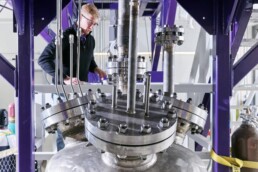
Molten salt test system drain tank. Courtesy Natura Resources
A molten salt reactor is different from a typical nuclear reactor because it uses liquid fuel instead of solid fuel. Liquid fuel provides advantages in efficiency and safety, and the research reactor will produce valuable data supporting the licensing of future commercial reactors.
Molten salt reactors are part of a new class of small, modular reactors. These facilities are smaller than large-scale power plants, but they can be built in more places, using smaller parts and less land. According to the International Energy Agency, the most realistic path to decarbonization by 2050 includes doubling nuclear energy.
“All eyes are on nuclear right now; student and industry interest is the highest it’s been in decades. We need more energy experts to engage with nuclear and to find ways to streamline licensing of advanced nuclear reactors to respond to the increased interest in nuclear energy.”
— Derek Haas, associate professor, Walker Department of Mechanical Engineering and Nuclear and Radiation Engineering Program
One way to streamline licensing is through the use of digital twins, which are physics-based models of complex, physical systems. The state of Texas recently granted UT $18.4 million to develop molten salt reactor digital twins.
Using digital twins with nuclear reactors could enable design to be quickly licensed and used because the software is continuously proven to be accurate,
said Kevin Clarno, a mechanical engineering professor who leads the nuclear program with Haas.
Methane Catchers
The global energy sector leaks about 135 million tons of methane each year, with most of that coming from coal, oil and natural gas facilities. Since methane is a highly potent greenhouse gas — its heat-trapping capacity is more than 28 times that of CO2 — reducing emissions can significantly improve the oil and gas industry’s environmental performance. Getting accurate real-time leakage data to inform repair efforts, however, is challenging.
Why? Because methane emissions data provided by the Environmental Protection Agency and its international counterparts is outdated, relies on a miniscule sample size and underestimates total emissions by about 60 percent. As a result, using existing technology and data to quantify just how much methane is being released (and exactly where it’s coming from) is costly and time-consuming, and depends on crucial factors like geographic location, time of day and year and facility age.
But the significant greenhouse gas reduction — and increased natural gas yield that results from quelling methane leaks — makes it a problem that industry, governmental and scientific stakeholders alike are intent on solving. If you remove methane emissions from the global energy sector, you get a reduction in warming that is equivalent to taking more than a billion cars off the road,
says Dave Allen, a chemical engineering professor. Such a feat could accomplish decades of climate progress in a matter of years.

Brad Crabtree, Assistant Secretary for the U.S. Department of Energy’s Office of Fossil Energy and Carbon Management, speaks with Arvind Ravikumar at an EEMDL event.
Allen and Arvind Ravikumar, an assistant professor in the Hildebrand Department of Petroleum and Geosystems Engineering, co-lead the Energy Emissions Modeling and Data Lab (EEMDL), a $50 million multi-disciplinary research and education initiative in partnership with Colorado School of Mines and Colorado State University. Now in its third year, EEMDL aims to provide accurate, timely and clear accounting of greenhouse gas emissions across global oil and natural gas supply chains. The lab also offers education and training programs to help oil and gas operators, government agencies and other stakeholders better utilize the tools and data.
With the protocols, software tools and comprehensive emissions datasets provided by EEMDL, both public and private institutions are able to develop informed climate strategies and identify significant opportunities for emissions reductions.
“Meeting methane reduction goals can be done much faster and often at a lower cost than other greenhouse gas reduction efforts. But emissions goals are only as good as the world’s capacity to track progress toward those goals. That’s why EEMDL exists — to build that capacity.”
— Arvind Ravikumar
Hydrogen Hotspot
Hydrogen’s appeal as an energy source lies in its abundance and versatility. Lots of fuels generate it as a byproduct; it can hold more energy per mass unit than any other fuel; and it produces only water vapor when combusted. But its low energy volume (about four times less than gasoline) and high reactivity are big challenges when it comes to storage and transportation.
More than 80 researchers across colleges and departments are exploring hydrogen research and leading important initiatives. UT energy leaders, including Korgel, are guiding the new $1.2 billion HyVelocity Hub. The goal is to capitalize on the region’s high concentration of existing hydrogen production and end-use assets to develop low-carbon intensity hydrogen that can power trucks, industrial processes, ammonia production, refining and petrochemical production, and marine shipping fuel.
Last year, a new hydrogen research and demonstration facility opened at UT. It represents the first time that multiple hydrogen production methods and uses will happen at the same site. The facility will generate zero-carbon hydrogen using water electrolysis powered by solar and wind energy, as well as steam methane reformation of renewable natural gas from a Texas landfill. The hydrogen will power a stationary fuel cell for clean, reliable energy for the Texas Advanced Computing Center and supply zero-emission fuel to a fleet of Toyota Mirai fuel cell electric vehicles and to fuel cell drones.
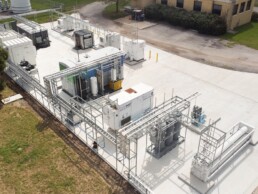
The first-of-its-kind hydrogen proto-hub opened at UT’s J.J. Pickle Research Campus in 2024 as part of an initiative led by the Center for Electromechanics, Frontier Energy and GTI Energy called H2@Scale.
Beyond scaling hydrogen production, researchers are investigating many other challenges. One example: Mojdeh Delshad, a globally recognized research professor in petroleum and geosystems engineering, is using numerical simulation tools to assess the suitability of saline aquifers and depleted oil and gas reservoirs for storing hydrogen. While aquifers are geologically simpler to model and can store large quantities of hydrogen with fewer reactions (thereby keeping the hydrogen purer and easier to use as an energy carrier), the hydrogen stored there is more likely to escape due to unproven sealing techniques and materials and requires expensive infrastructure to be successfully contained. Depleted hydrocarbon reservoirs already have that costly infrastructure in place, but it’s more likely that the hydrogen will react with the oil and gas and become less pure, making it less viable for energy use.
From the Vault: The Rise of Hydrogen
In all of these scenarios, accounting for the sheer volume of hydrogen to be stored, its tendency to migrate through even the smallest crack or fissure, and the corrosive impact it could have on pipes and wellbores is critical, says Delshad. These challenges highlight the need for optimized production and injection strategies to limit losses and maintain delivery rates,
she says. If we can’t successfully store hydrogen for the long term, we can’t scale up the hydrogen energy sector.
Carbon Snatchers
Carbon dioxide is an important and necessary component of Earth’s atmosphere. (Yes, you read that right.) CO2 keeps the surface temperature above freezing and conducive to life. But the exponential increase in atmospheric CO2 caused by humans burning fossil fuels for energy since the dawn of the Industrial Revolution led to too much warming too quickly.
Reducing the levels of atmospheric CO2 by removing it from the air and storing it underground permanently or for future use — called carbon capture, utilization and storage (CCUS) — is a critical component of reducing global temperature increases, particularly from sectors that are difficult to decarbonize such as heavy industry and transportation.
Much of the needed technology is already proven and viable,
says Ryosuke Okuno, professor of petroleum and geosystems engineering. But it needs to be scaled up and made economically advantageous to increase adoption across the energy industry.
Okuno leads the Energi Simulation Industrial Affiliate Program on Carbon UTilization and Storage (ES CarbonUT), a consortium of 15 corporate sponsors and five academic partners. A primary focus of ES CarbonUT’s work is dispersing nano-sized CO2 bubbles into water for CO2 mineralization. In a recent thermodynamic analysis, Okuno and his team found that the nanobubbles enable supersaturation of the water and speeds up CO2 mineralization in ultramafic rock formations. Using these nanobubbles means engineers can store more CO2 underground, use less water doing so, and minimize the amount that escapes.
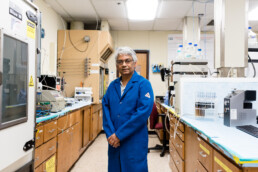
Kishore Mohanty.
Okuno’s departmental colleague, professor Kishore Mohanty, is also exploring innovative methods of storing CO2 in the subsurface. One project involves converting dissolved CO2 into carbonates by reacting it with alkaline industrial waste products, such as fly ash and alkaline rocks like basalt. Another takes existing steam methane reforming (SMR) technology used to create hydrogen from natural gas and utilizes it directly at a wellhead or reservoir. By injecting SMR-produced CO2 underground, engineers immediately trap the greenhouse gas while also increasing well pressure, which in turn increases natural gas production and the amount that can be converted to clean hydrogen.
The industry needs innovative and practical solutions like these,” says Mohanty. “They will allow us to continue using fossil fuels, which are still a critical component of reducing energy poverty in developing countries, while at the same time reducing CO2 emissions.
A Gritty Grid
Though it happened almost four years ago, the failure of the Texas power grid during Winter Storm Uri in February 2021 remains a top concern for many energy researchers. Connecting to other U.S. energy grids would help, but researchers across the Cockrell School are studying ways to optimize the grid, strengthening it against increasing climate threats and preparing it for increased energy demand.
The Webber Research Group, led by Michael Webber, has been a leading authority on the grid for years. In the last few years, Webber and his team have examined the winter storm from a variety of angles, studied residential heating’s impact on the grid and analyzed the impact of connecting Texas to other U.S. electrical grids.
Another way Texas Engineers are protecting the grid is by reimagining some of the key parts. Vaibhav Bahadur, associate professor of mechanical engineering, and Robert Hebner, former director of the Center for Electromechanics, used nanomaterials to increase the thermal conductivity of grid transformers, thereby cooling them off and potentially extending their life cycle.

Michael Webber discusses energy and space exploration at an event at the Paramount Theater in Austin celebrating the second season of his PBS show “Power Trip: The Story of Energy.”
Hao Zhu, associate professor in the Chandra Family Department of Electrical and Computer Engineering, researches computational tools for increasing the flexibility of the grid in daily operations. The grid is stressed now more than ever, and Zhu’s AI-empowered solutions aim to optimize grid topology to allow it to respond to more challenges.
In addition to a rise in extreme weather events, new energy technologies are rapidly transforming both the generation and consumption of electrical energy, including datacenter and AI computing demand, hydrogen, grid-scale storage and the electrification of industrial and transportation sectors,
said Zhu. Our solutions facilitate decision making during either the stage of real-time emergency response — whether that be a time of high demand or an extreme weather event — or post-outage restoration.
Rare Earth Elements
Rare Earth elements (REEs) are a group of 17 elements on the periodic table that includes neodymium, dysprosium, and lanthanum — and they are key components of decarbonizing technologies like wind turbines, electric vehicle motors, solar cells and more. The International Energy Agency (IEA) estimates global REE demand will increase at least fourfold by 2040.
Mining and extracting REEs is a complex, energy-intensive process that destroys land, consumes huge volumes of freshwater and emits hazardous acids, heavy metals and carbon dioxide. And most REEs are often found in remote or geopolitically sensitive locations.
Minimizing those risks while maximizing REE yield is one research focus of Wen Song, assistant professor of petroleum and geosystems engineering. Supported in part by a CAREER award from the National Science Foundation, Song and her team are exploring environmentally benign approaches to extract REEs from unconventional domestic sources, such as clay deposits and legacy coal ash waste.
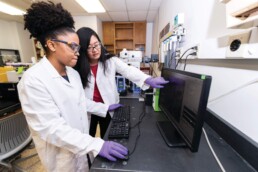
Inside Wen Song’s lab.
We hope to develop approaches to help secure the domestic supply of REEs, including the simultaneous valorization and remediation of legacy wastes,
says Song, who was named a 2024 Scialog Fellow in Sustainable Minerals, Metals and Materials. We hope to take a harmful waste material, and turn it into something useful to eliminate the critical bottleneck that a shortage of REEs poses to global decarbonization.
Optimized Oil
Much of the work happening in areas like carbon capture have important ramifications for fossil fuels — injecting CO2 and water into oil and gas reservoirs has long been a technique for maximizing yield. But Cockrell School researchers are also exploring innovative ways to use polymers, surfactants and other materials for enhanced oil recovery (EOR). Such EOR innovations mean fewer new wells need to be constructed to meet global oil and gas demand, which continues to grow despite the rise of solar, wind and other renewable technologies.
Professor Quoc Nguyen and his team, for example, are focused on EOR methods that use heat, gas and complex fluids like surfactants, polymers, nanoparticles, foams and gels. Mohanty, Song and professor Michael Pyrcz are modifying the ionic composition of injected water and adding surfactants or nanoparticles to improve oil recovery in fractured carbonate reservoirs. And Mohanty and petroleum and geosystems department chair Matt Balhoff are leading a research team of 30+ to explore chemical EOR methods that include polymer flooding, surfactant flooding, mobility control using foam, low-salinity water flooding, shale stimulation and hybrid chemical-thermal solutions.

Matt Balhoff.
“Our research is important because much of the world’s easily accessible oil has already been extracted. By increasing oil production from existing reservoirs, we are not only extending the life of these oil fields but we are also making these processes more cost-effective and environmentally sustainable.”
— Matt Balhoff
AI’s Impact
The rise of artificial intelligence is a not just a technology story, but an energy one. AI already demands a massive amount of energy, and that is poised to rise in years to come.
The data centers where these AI models live are expected to increase their energy consumption anywhere from 35% to 128% by 2026, according to the IEA. That’s roughly equivalent to adding at least one Sweden to global energy demands at the low end or one Germany at the high end.
Guihua Yu, professor of materials science in the Walker Department of Mechanical Engineering, is tackling this challenge. Yu, who has made breakthroughs in a variety of energy-adjacent areas, including generating clean water from the atmosphere and improving batteries, is now tackling cooling for high-powered electronics.
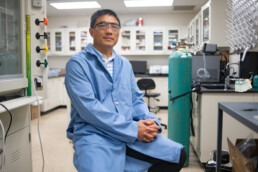
Guihua Yu.
Yu and his team recently developed a new thermal interface material
that could organically remove heat from high-powered electronic devices, reducing or even eliminating the need for extensive cooling. Cooling accounts for about 40% of data center energy usage, or 8 terawatt-hours annually. The researchers estimate their technology could shave 13% off that cooling requirement — or 5% off overall data center energy usage — a significant savings if applied across the industry. The heat dissipation capabilities also allow for significant growth in processing power.
The power consumption of cooling infrastructure for energy-intensive data centers and other large electronic systems is skyrocketing,
Yu said about his new research published late last year. That trend isn’t dissipating anytime soon, so it’s critical to develop new ways, like the material we’ve created, for efficient and sustainable cooling of devices operating at kilowatt levels and even higher power.
Battery Brilliance
In the next six years, demand for batteries, driven by the proliferation of electric vehicles, is expected to quadruple. With a foundation that dates back to Nobel Prize-winning battery pioneer John Goodenough’s arrival at UT Austin in the 1980s, Cockrell will play a critical role in meeting this demand.
Goodenough is considered the inventor of the lithium-ion battery, and his colleagues and proteges are working tirelessly to improve these innovations. Texas Engineers are addressing every aspect of battery innovation, aiming to enhance life cycle and safety, develop new materials, create storage solutions and reduce cost and charging time.
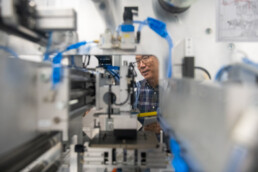
A look inside the new battery production facility at UT.
In recent years, Texas Engineers have found new ways to monitor batteries. They’ve developed batteries that use sodium instead of lithium and cobalt, which are expensive and fraught with environmental and human rights concerns. And they have worked to make batteries safer by becoming more fire resistant.
A new battery fabrication facility will bolster these efforts, allowing researchers to test their innovations with state-of-the-art fabrication equipment. This facility will enable the production of larger cells, enhancing research into electric vehicles, energy storage and other challenges at scale.
This new facility will round out the Cockrell School’s battery expertise,
said Ofodike Ezekoye, professor in the Walker Department of Mechanical Engineering, who leads the battery facility and UT’s Fire Research Group. Batteries are critical to safely advance technology in an efficient and environmental way, and at the Cockrell School we are investigating this from all angles.
WOULD YOU LIKE TO KNOW MORE?
See what the Cockrell School has in store for the Future of Energy.